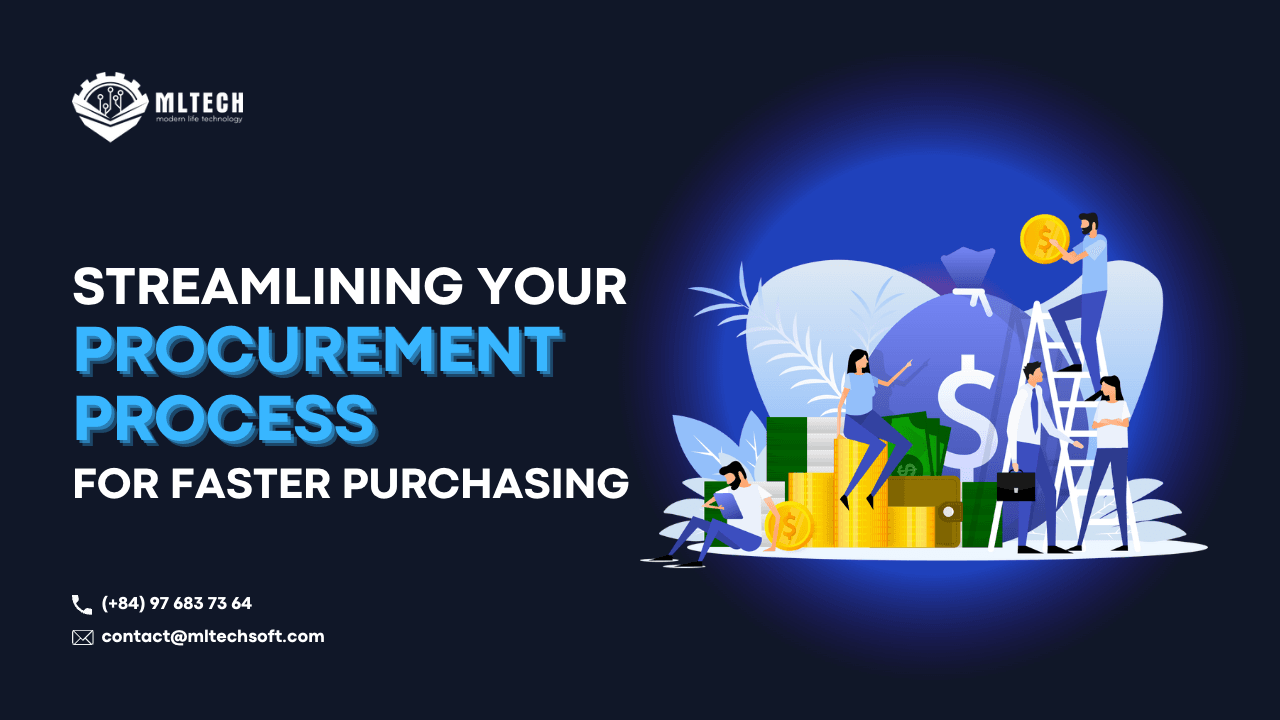Scroll down for more
Streamlining Your Procurement Process for Faster Purchasing

64% of companies admit that supply chain disruption has been the biggest challenge over the last year. Without effective best practices in place, your procurement processes could fall victim to this kind of disruption.
This not only slows down and makes your procurement process less efficient, but it also hurts customer satisfaction and puts relationships with key suppliers at risk. To prevent this, it’s your responsibility to streamline your procurement process for end-to-end efficiency.
Read on to learn the procurement best practices that will help you eliminate bottlenecks in your processes and keep your purchasing workflows ticking over smoothly.
Procurement process and importance of streamlining for faster purchasing
The role of procurement is always changing from a back-office administrative task to a strategic business task. Procurement is more than just purchasing goods and services; it has moved to managing and deriving value from the supplier relationship.
In rebate management, their role involves identifying the right supplier, evaluating supplier performance, and negotiating trading agreements that can provide the highest value at the lowest cost. Procurement also has a major influence on the overall costs of the business, and cost reduction represents a huge portion of their rebate management strategy.

Streamlining procurement processes helps us make faster purchases and can have several important benefits for businesses, including:
Improved efficiency: Streamlining procurement processes eliminates manual tasks, reduces errors, and speeds up processing times. This leads to more efficient purchasing and enables procurement teams to focus on more strategic activities.
Cost savings: Streamlining procurement processes can lead to significant cost savings by reducing administrative overheads, eliminating redundancies, and improving the accuracy of purchasing data. It also allows businesses to negotiate better pricing with suppliers and identify cost-saving opportunities.
Increased agility: Streamlining procurement processes enables businesses to be more responsive to changes in the market, demand, or supplier availability. This flexibility allows businesses to adjust their purchasing strategies quickly and seize new opportunities.
Better supplier relationships: Effective vendor selection and management practices foster better relationships with suppliers, leading to more reliable and efficient delivery of goods and services. This reduces the risk of supply chain disruptions and improves the overall quality of the procurement process.
Pain Points in Procurement
Overview of common pain points in procurement
Procurement can be a complex and challenging process, and businesses may face several common pain points that can hinder its effectiveness. Manual processes such as data entry, approval workflows, and document handoffs can be time-consuming, error-prone, and slow down the procurement process. If you don't manage your suppliers well, they might not do their jobs well, the supply chain might get messed up, and you might miss out on chances to negotiate better prices and terms.
If you can't see what's going on in the procurement process, it can be hard to find inefficiencies, keep track of spending, and manage budgets well. When stakeholders, like procurement teams, suppliers, and end users, don't talk to each other well, it can lead to misunderstandings, delays, and wrong orders. When data is wrong or missing, it can lead to buying decisions that are based on wrong or unreliable information. This can lead to higher costs and less efficient procurement processes.
If you don't follow rules, policies, or contracts, you could face legal and financial risks, damage to your reputation, and problems with your supply chain. Lack of automation tools such as e-procurement systems, contract management software, and spend management tools can make the procurement process slow and inefficient. Addressing these pain points can help businesses streamline the procurement process and make it more effective.

Examples of how these pain points slow down purchasing
We will give you some examples of how these pain points slow down purchasing:
Manual processes:
If data entry is done manually, it can take a long time to input all the necessary information. This can lead to delays in processing purchase orders, approvals, and invoices. Manual processes can also result in errors, such as typos or incorrect data, which can further slow down the process.
Inefficient supplier management:
If the procurement team does not have a clear understanding of their supplier's capabilities or pricing structure, they may waste time negotiating with suppliers that cannot meet their needs. This can lead to delays in the purchasing process as the team must start the supplier selection process over again.
Lack of visibility:
Without clear visibility into the procurement process, the procurement team may not know what purchases have been made, how much has been spent, or where the budget stands. This can lead to delays in making purchasing decisions, as the team must spend time gathering information to make informed decisions.
Poor communication:
If there is a lack of communication between the procurement team, end-users, and suppliers, misunderstandings can occur. This can lead to delays in the procurement process as the team must spend time resolving these misunderstandings.
Inaccurate data:
If the procurement team is working with inaccurate or incomplete data, it can lead to delays in making purchasing decisions. For example, if the team is using outdated pricing information, they may submit purchase orders with incorrect pricing, which can delay the purchasing process.
Compliance issues:
If the procurement team is not aware of compliance regulations or policies, they may inadvertently purchase goods or services that are not compliant. This can lead to delays in the purchasing process as the team must spend time resolving compliance issues.
Lack of automation:
If the procurement team is manually processing purchase orders, approvals, and invoices, it can be a time-consuming process that can slow down the procurement process. Automation can speed up the process by eliminating manual tasks and streamlining the workflow.
Strategies for Streamlining Procurement
Automation tools for procurement
Procurement is one of your core business activities, as it affects almost every aspect of your company’s operations and profit margins. Yet so often, purchasing teams have to work with outdated processes and tools.
Procurement automation software removes the need for manual processing. Instead, repetitive tasks such as data entry, record updates, approvals, and document hand-offs are automated to speed up processing, boost cost savings, and reduce errors.

Best practices for vendor selection and management
Effective vendor selection and management are crucial for optimizing procurement processes. Best practices include clearly defining your company’s needs, conducting market research, evaluating vendors based on key factors, negotiating contracts, and regularly monitoring vendor performance
Collaboration and communication strategies
Collaboration and communication are essential for effective procurement. Strategies include establishing clear communication channels, using technology to enable real-time collaboration, developing standard operating procedures, holding regular meetings with vendors, and fostering a culture of transparency and open communication.
Benefits of Streamlining Procurement
Faster purchasing and delivery times
Streamlining procurement processes allows for faster purchasing and delivery times by reducing the time spent on manual tasks such as data entry, approval processes, and document hand-offs. This results in a more efficient procurement process, reducing lead times, and ensuring faster delivery of goods and services.

Lower costs and better budget management:
Streamlining procurement processes can help lower costs and improve budget management by identifying cost-saving opportunities and reducing administrative overheads. Automation tools can also help to eliminate redundancies and improve the accuracy of purchasing data, ensuring that budget allocations are optimized and effectively managed.
Improved supplier relationships and contract management:
Effective vendor selection and management practices foster better relationships with suppliers, leading to more reliable and efficient delivery of goods and services. This reduces the risk of supply chain disruptions and improves the overall quality of the procurement process. Contract management software can also help streamline the contract management process, ensuring compliance and reducing legal and financial risks.
Conclusion
To keep up with changing needs and ensure that business spend is under control, procurement processes should be amended and modern purchasing tools must be utilized. Modern purchasing processes help ensure that the business gets what it needs at the best price, under good terms, within budget, and without any misconduct—fast. These benefits and others are a must for companies aiming to continue growing through 2023 and beyond.
Get our blog
Want the latest and greatest from our blog straight to your inbox? Chunk us your details and get a sweet weekly email.
Read more in our blog

Project Management
The Rise of AI-Generated Code: Opportunities & ChallengesExplore how AI-generated code is transforming programming with tools like GitHub Copilot and AlphaCode. Learn about the opportunities it offers—faster development, accessibility—and the challenges like security and ethics we must address.

Project Management
The Impact of Dynamic Pricing on Customer BehaviorExplore the impact of dynamic pricing on customer behavior and learn how to implement effective pricing strategies.

Project Management
Focus in Scrum: Keeping Your Team on TrackDiscover effective strategies to maintain focus within your Scrum team, overcome common challenges, and boost productivity.
MLTECH SOFT